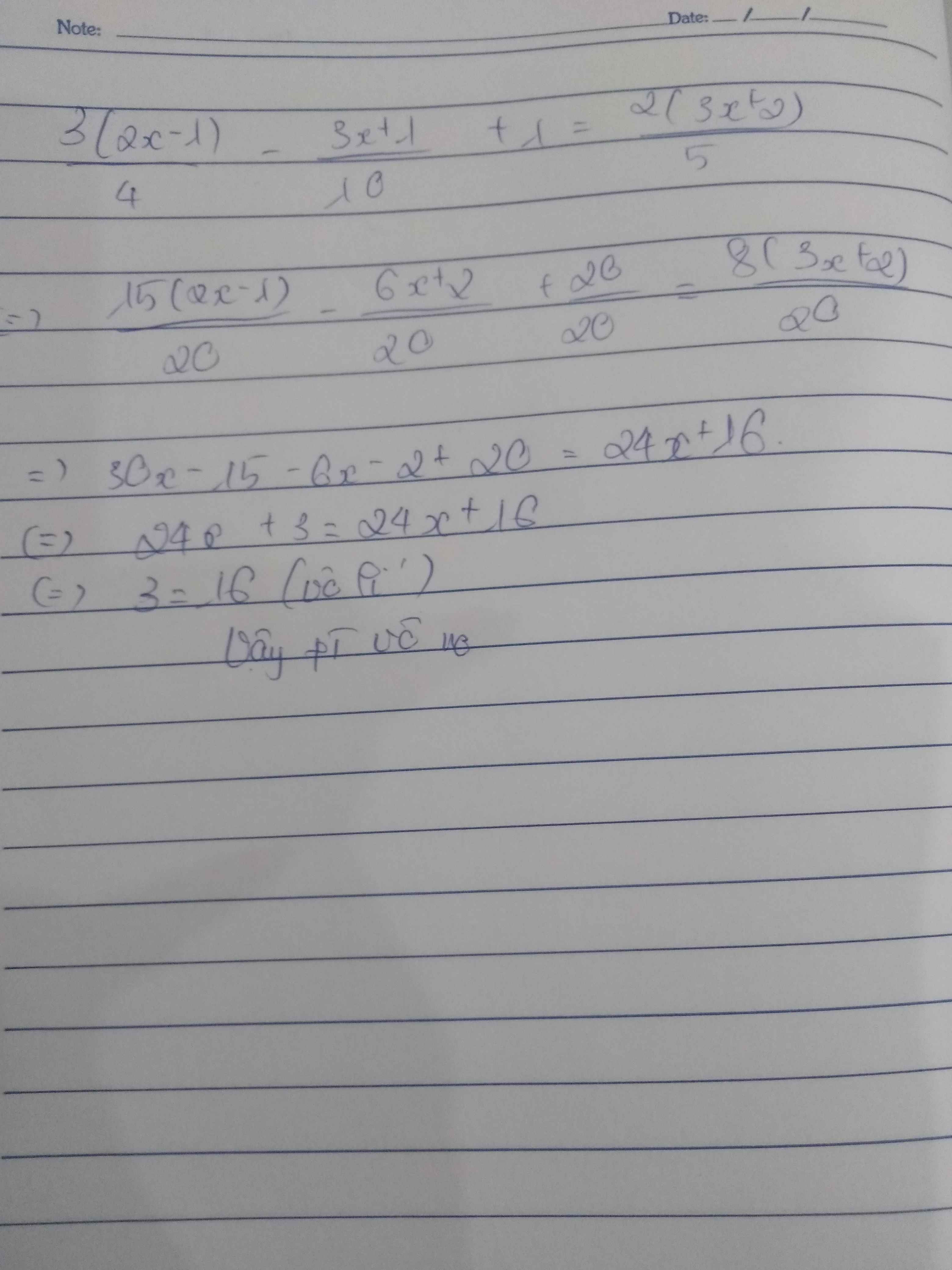2(1-3x)/5-2+3x/10=8-(2x+1)/4 (giải pt)
Hãy nhập câu hỏi của bạn vào đây, nếu là tài khoản VIP, bạn sẽ được ưu tiên trả lời.


ta có : x^5+2x^4+3x^3+3x^2+2x+1=0
\(\Leftrightarrow\)x^5+x^4+x^4+x^3+2x^3+2x^2+x^2+x+x+1=0
\(\Leftrightarrow\)(x^5+x^4)+(x^4+x^3)+(2x^3+2x^2)+(x^2+x)+(x+1)=0
\(\Leftrightarrow\)x^4(x+1)+x^3(x+1)+2x^2(x+1)+x(x+1)+(x+1)=0
\(\Leftrightarrow\)(x+1)(x^4+x^3+2x^2+x+1)=0
\(\Leftrightarrow\)(x+1)(x^4+x^3+x^2+x^2+x+1)=0
\(\Leftrightarrow\)(x+1)[x^2(x^2+x+1)+(x^2+x+1)]=0
\(\Leftrightarrow\)(x+1)(x^2+x+1)(x^2+1)=0
VÌ x^2+x+1=(x+\(\dfrac{1}{2}\))^2+\(\dfrac{3}{4}\)\(\ne0\) và x^2+1\(\ne0\)
\(\Rightarrow\)x+1=0
\(\Rightarrow\)x=-1
CÒN CÂU B TỰ LÀM (02042006)
b: x^4+3x^3-2x^2+x-3=0
=>x^4-x^3+4x^3-4x^2+2x^2-2x+3x-3=0
=>(x-1)(x^3+4x^2+2x+3)=0
=>x-1=0
=>x=1

a. \(3-4x\left(25-2x\right)-8x^2+x-300=0\)
\(\Leftrightarrow3-100x+8x^2-8x^2+x-300=0\)
\(\Leftrightarrow-297-99x=0\)
\(\Leftrightarrow x=3\)
Vậy \(n_0\) của PT là: x=3
b. \(\Leftrightarrow\frac{\left(2-6x\right)}{5}-2+\frac{3x}{10}=7-\frac{3x+3}{4}\)
\(\Leftrightarrow\frac{\left(4-12x\right)}{5}-\frac{20}{10}+\frac{3x}{10}=\frac{\left(28-3x-3\right)}{4}\)
\(\Leftrightarrow\frac{\left(-16-9x\right)}{10}=\frac{\left(25-3x\right)}{4}\)
\(\Leftrightarrow-64-36x=250-30x\)
\(\Leftrightarrow-6x=314\)
\(\Leftrightarrow x=-\frac{157}{3}\)
Vậy -\(n_0\) của PT là: \(x=\frac{-157}{3}\)
c. \(5x+\frac{2}{6}-8x-\frac{1}{3}=4x+\frac{2}{5}-5\)
\(\Leftrightarrow-3x=4x-\frac{23}{5}\)
\(\Leftrightarrow7x=\frac{23}{5}\)
\(\Leftrightarrow x=\frac{23}{35}\)
Vậy \(n_0\) của PT là: \(x=\frac{23}{35}\)
d. \(3x+\frac{2}{3}-3x+\frac{1}{6}=2x+\frac{5}{3}\)
\(\Leftrightarrow\frac{5}{6}=2x+\frac{5}{3}\)
\(\Leftrightarrow x=-\frac{5}{12}\)
Vậy \(n_0\) của Pt là: \(x=-\frac{5}{12}\)

Để giải các phương trình này, chúng ta sẽ làm từng bước như sau: 1. 13x(7-x) = 26: Mở ngoặc và rút gọn: 91x - 13x^2 = 26 Chuyển về dạng bậc hai: 13x^2 - 91x + 26 = 0 Giải phương trình bậc hai này để tìm giá trị của x. 2. (4x-18)/3 = 2: Nhân cả hai vế của phương trình với 3 để loại bỏ mẫu số: 4x - 18 = 6 Cộng thêm 18 vào cả hai vế: 4x = 24 Chia cả hai vế cho 4: x = 6 3. 2xx + 98x2022 = 98x2023: Rút gọn các thành phần: 2x^2 + 98x^2022 = 98x^2023 Chia cả hai vế cho 2x^2022: x + 49 = 49x Chuyển các thành phần chứa x về cùng một vế: 49x - x = 49 Rút gọn: 48x = 49 Chia cả hai vế cho 48: x = 49/48 4. (x+1) + (x+3) + (x+5) + ... + (x+101): Đây là một dãy số hình học có công sai d = 2 (do mỗi số tiếp theo cách nhau 2 đơn vị). Số phần tử trong dãy là n = 101/2 + 1 = 51. Áp dụng công thức tổng của dãy số hình học: S = (n/2)(a + l), trong đó a là số đầu tiên, l là số cuối cùng. S = (51/2)(x + (x + 2(51-1))) = (51/2)(x + (x + 100)) = (51/2)(2x + 100) = 51(x + 50) Vậy, kết quả của các phương trình là: 1. x = giá trị tìm được từ phương trình bậc hai. 2. x = 6 3. x = 49/48 4. S = 51(x + 50)

a) (2x + 1)(3x - 2) = (5x - 8)(2x + 1)
<=> 6x2 - x - 2 = 10x2 - 11x - 8
<=> 6x2 - 10x2 - x + 11x -2 + 8 = 0
<=> -4x2 + 10x + 6 = 0
<=> -2 (2x2 - 5x - 3) = 0
<=> 2x2 - 5x - 3 = 0
<=> 2x2 - 6x + x - 3 = 0
<=> x (2x + 1) - 3 (2x + 1) = 0
<=> (x - 3) (2x + 1) = 0
* x - 3 = 0 => x = 3
* 2x + 1 = 0 => x = -1/2
S = {-1/2; 3}
b) 4x2 – 1 = (2x +1)(3x -5)
<=> 4x2 – 1 - (2x +1)(3x -5) = 0
<=> (2x - 1) (2x + 1) - (2x + 1)(3x - 5) = 0
<=> (2x + 1) (2x - 1 - 3x + 5) = 0
<=> (2x + 1) (-x + 4) = 0
* 2x + 1 = 0 <=> x = -1/2
* -x + 4 = 0 <=> x = 4
S = {-1/2; 4}
c) (x + 1)2 = 4(x2 – 2x + 1)
<=> (x + 1)2 - 4(x2 – 2x + 1) = 0
<=> (x + 1)2 - 4(x2 – 1)2 = 0
* (x + 1)2 = 0 <=> x = -1
* 4(x2 - 1)2 = 0 <=> x = 1 và x = -1
S = {-1; 1}
d) 2x3 + 5x2 – 3x = 0
<=> x (2x2 + 5x - 3) = 0
<=> x (2x2 + 6x - x - 3) = 0
<=> x [x(2x - 1) + 3 (2x - 1)] = 0
<=> x (2x - 1) (x + 3) = 0
* x = 0
* 2x - 1 = 0 <=> x = 1/2
* x + 3 = 0 <=> x = -3
S = { -3; 0; 1/2}

a) \(x^5+2x^4+3x^3+3x^2+2x+1=0\)
\(\Leftrightarrow x^5+x^4+x^4+x^3+2x^3+2x^2+x^2+x+x+1=0\)
\(\Leftrightarrow x^4\left(x+1\right)+x^3\left(x+1\right)+2x^2\left(x+1\right)+x\left(x+1\right)+\left(x+1\right)=0\)
\(\Leftrightarrow\left(x+1\right)\left(x^4+x^3+2x^2+x+1\right)=0\)
\(\Leftrightarrow\left(x+1\right)\left(x^4+x^3+x^2+x^2+x+1\right)=0\)
\(\Leftrightarrow\left(x+1\right)\left[x^2\left(x^2+x+1\right)+\left(x^2+x+1\right)\right]=0\)
\(\Leftrightarrow\left(x+1\right)\left(x^2+x+1\right)\left(x^2+1\right)=0\)
Dễ thấy \(x^2+x+1>0\forall x;x^2+1>0\forall x\)
\(\Rightarrow x+1=0\)
\(\Leftrightarrow x=-1\)
Vậy....
b) \(x^4+3x^3-2x^2+x-3=0\)
\(\Leftrightarrow x^4-x^3+4x^3-4x^2+2x^2-2x+3x-3=0\)
\(\Leftrightarrow x^3\left(x-1\right)+4x^2\left(x-1\right)+2x\left(x-1\right)+3\left(x-1\right)=0\)
\(\Leftrightarrow\left(x-1\right)\left(x^3+4x^2+2x+3\right)=0\)
...
\(\Leftrightarrow x=1\)
p/s: có bác nào giải đc pt \(x^3+4x^2+2x+3=0\)thì giúp nhé :))

a, đk : x >= 1
\(\left[{}\begin{matrix}3x+5=2x-2\\3x+5=2-2x\end{matrix}\right.\Leftrightarrow\left[{}\begin{matrix}x=-7\\x=-\dfrac{3}{5}\end{matrix}\right.\left(ktm\right)\)
vậy pt vô nghiệm
b, đk >= 0
\(\left[{}\begin{matrix}x^2+1=2x\\x^2+1=-2x\end{matrix}\right.\Leftrightarrow\left[{}\begin{matrix}\left(x-1\right)^2=0\\\left(x+1\right)^2=0\end{matrix}\right.\Leftrightarrow\left[{}\begin{matrix}x=1\left(tm\right)\\x=-1\left(ktm\right)\end{matrix}\right.\)
c, \(\left[{}\begin{matrix}2x^2+2x=0\\2x^2+4x+2=0\end{matrix}\right.\Leftrightarrow\left[{}\begin{matrix}2x\left(x+1\right)=0\\x^2+2x+1=0\end{matrix}\right.\Leftrightarrow\left[{}\begin{matrix}x=0;x=-1\\x=-1\end{matrix}\right.\)



\(\dfrac{2\left(1-3x\right)}{5}-2+\dfrac{3x}{10}=8-\dfrac{2x+1}{4}\)
\(\Leftrightarrow\dfrac{8\left(1-3x\right)}{20}-\dfrac{40}{20}+\dfrac{6x}{20}=\dfrac{160}{20}-\dfrac{5\left(2x+1\right)}{20}\)
\(\Leftrightarrow8\left(1-3x\right)-40+6x=160-5\left(2x+1\right)\)
\(\Leftrightarrow8-24x-40+6x=160-10x-5\)
\(\Leftrightarrow-18x-32=155-10x\)
\(\Leftrightarrow-18x+10x=155+32\)
\(\Leftrightarrow-8x=187\)
\(\Leftrightarrow x=-\dfrac{187}{8}\)
Vậy: ...